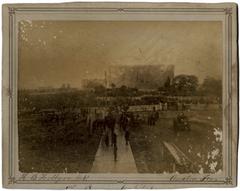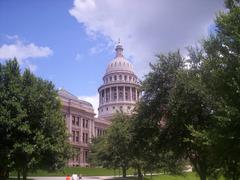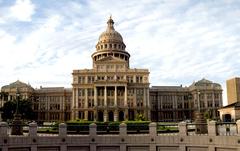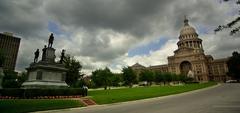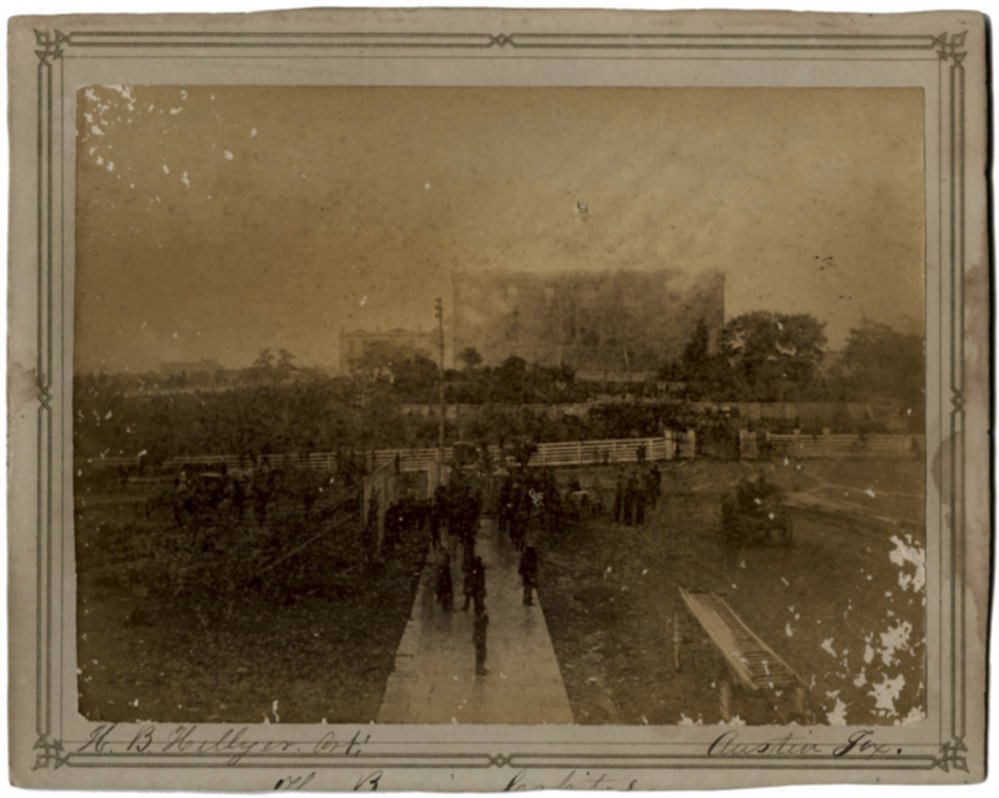
Texas State Capitol Visiting Hours, Tickets, and Austin Historical Sites Guide
Date: 14/06/2025
Introduction
The Texas State Capitol in Austin stands as a powerful symbol of Texan heritage, politics, and architectural grandeur. Completed in 1888, this Renaissance Revival masterpiece was designed by Elijah E. Myers and showcases a striking “sunset red” granite exterior and a dome that rises 308 feet—taller than the United States Capitol in Washington, D.C. Beyond its function as the seat of state government, the Capitol is a vibrant cultural hub, attracting millions each year to its historic halls and expansive, monument-studded grounds. This comprehensive guide will help you navigate visiting hours, ticketing, accessibility, and nearby attractions, ensuring a memorable and meaningful visit to one of Austin’s most iconic sites. For up-to-date details and virtual resources, consult the Texas State Preservation Board (tspb.texas.gov), Texapedia, and AustinTexas.org.
Table of Contents
- Origins and Early Development
- Architectural Significance
- The Capitol’s Role in Texas History
- Preservation and Recognition
- Exploring the Capitol Grounds
- Planning Your Visit: Hours, Tickets, and Accessibility
- Cultural and Educational Impact
- Visiting FAQs
- Enhancing Your Visit: Visuals & Virtual Tours
- Nearby Austin Attractions
- Tips for a Memorable Visit
- Group Visits and Seasonal Considerations
- Key Takeaways & Further Resources
Origins and Early Development
The Texas State Capitol’s story mirrors the growth of Texas itself. The original wooden capitol, built after Texas joined the United States in 1845, was replaced by a Greek Revival structure in 1853. When that building was destroyed by fire in 1881, a nationwide design competition led to the commission of Elijah E. Myers, whose vision reflected Texas’s ambition and identity. Construction started in 1882 and culminated in 1888, marking a new chapter in the state’s legislative and architectural history (e-a-a.com; texasluxuryhouses.net).
Architectural Significance
Renaissance Revival Style
The Capitol is a landmark example of Renaissance Revival architecture, blending classical proportions, symmetry, and ornate detail. Myers’s design features a 60-foot-wide rotunda under a cast-iron dome, clad in local “sunset red” granite quarried from Marble Falls. The building’s pinkish hue and towering dome reflect Texas pride and independence, while the four main floors and a modern underground extension (completed in the 1990s) provide over 360,000 square feet of space (thetouristchecklist.com).
Dome, Craftsmanship, and Symbolism
The Capitol’s double dome—engineered with iron and clad in sheet metal—soars above the rotunda, topped by the Goddess of Liberty statue. Interior highlights include marble floors, grand staircases, and custom fixtures such as ornate brass chandeliers whose bulbs spell out “T-E-X-A-S.” The rotunda features portraits of every Texas governor and president of the Republic of Texas, creating a visual timeline of state leadership (Texapedia; State Preservation Board).
The Capitol’s Role in Texas History
Serving as the seat of the Texas Legislature and the Governor’s office since 1888, the Capitol has been the stage for major legislative decisions, civil rights advancements, and political debates shaping the state and nation. It continues to host legislative sessions, committee hearings, public rallies, and civic events, reinforcing its status as a center of democracy and public participation (e-a-a.com; AustinTexas.org; GovExperts).
Preservation and Recognition
Major restoration projects—including a comprehensive effort in the 1990s—have preserved the Capitol’s historical and architectural integrity while adding modern amenities. Recognized as a National Historic Landmark, a Recorded Texas Historic Landmark, and listed on the National Register of Historic Places, the Capitol is maintained by the State Preservation Board, which also offers educational programs and public tours (e-a-a.com; tspb.texas.gov; Facts.net).
Exploring the Capitol Grounds
The 22-acre Capitol grounds function as an open-air museum, with more than 20 monuments and memorials commemorating key figures and events in Texas history—from the Heroes of the Alamo and African American legislators to the Texas Peace Officers’ Memorial. Shaded walkways, expansive lawns, and gardens offer an inviting space for visitors and locals alike, and serve as a venue for public demonstrations and celebrations (thetouristchecklist.com; texasluxuryhouses.net; Austin Insider Blog).
Planning Your Visit: Hours, Tickets, and Accessibility
Hours
- Capitol Building: Open daily, typically 7:00 AM–10:00 PM (check tspb.texas.gov for current hours).
- Visitor Center: Open Monday–Saturday, 8:30 AM–4:30 PM.
Admission & Tickets
- Admission: Free for all; no tickets required.
- Guided Tours: Free tours are available daily and typically last 30–45 minutes. For large groups, advance reservations are recommended.
Accessibility
- The Capitol is fully accessible, with ramps, elevators, and assistive services. Service animals are permitted. For specific accommodations, visit the Accessibility Services page.
Travel Tips
- Arrive early, especially during peak seasons or legislative sessions.
- Comfortable shoes are recommended due to extensive walking.
- Photography is encouraged (except where restricted).
- Security screening is required for all visitors.
(tspb.texas.gov; AustinTexas.org)
Cultural and Educational Impact
The Capitol is a living museum and educational resource, welcoming millions each year to learn about Texas history, architecture, and government. The Capitol Visitors Center offers rotating and permanent exhibits, interactive displays, and educational programs for students and families. Its commitment to accessibility and free admission makes it a welcoming destination for all (thetouristchecklist.com; SeeSight Tours).
Visiting FAQs
Q: What are the Texas State Capitol visiting hours?
A: Open daily; hours vary by day—check the official website for current times.
Q: Is admission or a ticket required?
A: Admission and tours are free; no tickets are needed.
Q: Are guided tours available?
A: Yes, free guided tours are offered daily. Reservations are recommended for groups.
Q: Is the Capitol accessible?
A: Yes, with ramps, elevators, and other accommodations.
Q: Can I take photos inside?
A: Yes, except where restricted.
Q: Is parking available?
A: Limited parking is available nearby; public transit or rideshare is recommended during busy times.
Enhancing Your Visit: Visuals & Virtual Tours
Explore high-quality images, videos, and interactive virtual tours on the Texas State Preservation Board website and Texapedia. These resources are excellent for planning your route or previewing the Capitol’s architectural highlights and grounds.
Nearby Austin Attractions
Enhance your Capitol visit by exploring nearby sites such as the Bob Bullock Texas State History Museum, the LBJ Presidential Library, the Governor’s Mansion, and Austin’s vibrant 6th Street district. These destinations provide deeper context to Texas’s political and cultural landscape.
Tips for a Memorable Visit
- Arrive Early: To avoid crowds, especially during peak seasons.
- Check for Events: Review the official calendar for special events or closures.
- Prepare for Security: Allow extra time for screening and review the prohibited items list.
- Dress Comfortably: Expect to walk and stand for extended periods.
- Combine Visits: Plan for stops at other historical sites nearby.
Group Visits and Seasonal Considerations
During legislative sessions (January–May in odd-numbered years), the Capitol is especially active, and some areas may be restricted. Large groups and school field trips should reserve tours in advance and can take advantage of specialized educational programs.
Key Takeaways & Further Resources
Visiting the Texas State Capitol offers a unique opportunity to engage with Texas’s living history, from its grand architecture and legislative chambers to its monument-filled grounds. Free admission and guided tours ensure accessibility for all, while ongoing preservation keeps this landmark vibrant for future generations. To plan your visit, learn about special events, or access audio guides and interactive maps, consult the Texas State Preservation Board, and consider downloading the Audiala app for an enhanced experience.
References and Official Sources
- https://www.e-a-a.com/architecture-behind-texas-state-capitol-austin-tx/
- https://texapedia.info/capitol/
- https://www.austintexas.org/listings/texas-state-capitol/1983/
- https://tspb.texas.gov/plan/tours/tours.html
- https://thetouristchecklist.com/texas-state-capitol/
- https://facts.net/world/landmarks/11-texas-capitol-building-facts/
- https://guidetoaustinarchitecture.com/places/texas-state-capitol/
- https://www.seesight-tours.com/blog/interesting-facts-to-know-about-the-texas-capitol-before-your-visit
- https://govexperts.com/texas-capitol/
